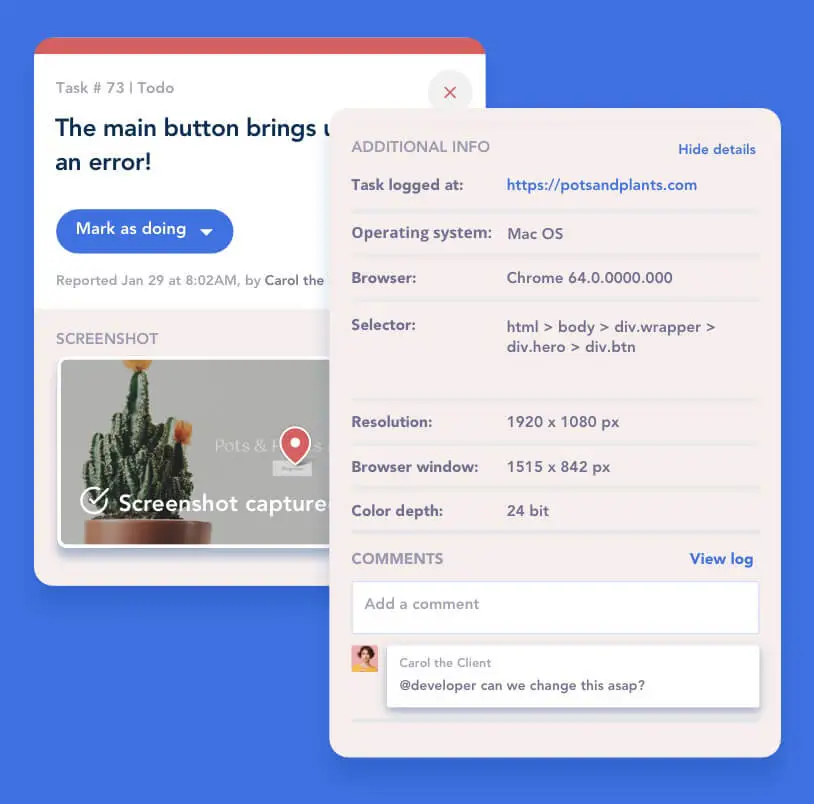Are you a developer, designer, or project manager browsing a website and noticing a glaring bug? Welcome to our BugHerd Review. You can see the issue right there on your screen but struggle to describe it clearly.
Now, what if there was a tool to make this more straightforward? A software/tool such as BugHerd.
This software allows you to pinpoint issues directly on the webpage. All you have to do is click on the problem area to leave feedback.
From experience and user reviews about BugHerd, it transforms the process of giving website feedback into a visual and intuitive experience.
The software is designed to streamline your workflow and ensure issues are addressed promptly. Making your projects on track.
In this article, we’ll be doing a deep dive into what makes BugHerd a must-have for developers, designers, and project managers.
READ ALSO: Deel Review | Choosing the Right Global Payroll Service for Your Business
What is BugHerd?
BugHerd is a new-age visual bug-tracking software and also has a feedback tool designed to streamline website development and testing.
Simply put; BugHerd is a user-friendly bug tracking tool for websites.
Think of it as a layer on your website where you can pin feedback and bugs directly onto elements that need attention. Just like sticky notes but way smarter and all digital.
The BugHerd software works by embedding a sidebar onto your website.
This sidebar then allows users to pin feedback directly on the website elements they are commenting on. With this visual approach, it more easier for teams to identify and address issues quickly and accurately.
This is particularly useful during the design, development, and QA stages of a project, ensuring all feedback is captured in the context of the website itself.
Who Can Use BugHerd?
The BugHerd software is designed to streamline your workflow, whether you’re a:
- Designer
- Developer
- QA Tester
- Project Manager
It lets you gather feedback directly on your website, making issue management and resolution much simpler. No more endless email threads or confusing spreadsheets.
It centralizes all your feedback in one intuitive platform.
READ ALSO: How To Safeguard Your Identity From Cyber Criminals (Online Security Tips)
How Does BugHerd Work?
Here’s a step-by-step look at how BugHerd works:
Installation and Setup:
- You simply install a small piece of JavaScript code on your website. This can be done manually or through various integrations like WordPress plugins or third-party tools.
- Once installed, BugHerd activates a toolbar on your website which is accessible to authorized users who can then start providing feedback instantly.
Collecting Feedback:
- Users can click on any element of the webpage to leave a comment or report a bug.
- Clicking opens a feedback form where users can describe the issue, attach screenshots, and add necessary details.
- Each feedback entry is automatically pinned to a specific part of the webpage, ensuring clarity on which element is affected.
Managing Feedback and Bugs:
- All feedback and bug reports are centralized in BugHerd’s dashboard.
- Team members can review, prioritize, and assign tasks within the dashboard.
- Feedback is visually organized using a Kanban board interface. This allows teams to track the status of each issue from start to resolution.
Detailed Bug Reports:
- BugHerd automatically captures essential metadata with each bug report. It includes the browser version, operating system, screen resolution, and the exact URL where the issue occurred. This data helps developers replicate and fix issues more efficiently.
Collaboration and Communication:
- Team members can comment on feedback and bugs directly within the BugHerd interface, facilitating clear and concise communication.
- Clients and stakeholders can also be invited to leave feedback, making it easy to gather input from all relevant parties without overwhelming them with technical details.
BugHerd enhances collaboration and efficiency by simplifying the feedback and bug-tracking process. This allows teams to focus on building and refining high-quality websites.
BugHerd Features
BugHerd packs several powerful features:
- Visual Feedback Tool: Pin bugs and feedback directly on your website. This makes it easier to convey exactly what needs to be fixed, eliminating misunderstandings.
- Task Management: Create, assign, and track tasks effortlessly. BugHerd’s task management features integrate seamlessly with its feedback tool, allowing teams to manage their workflow within a single interface.
- Project Planning: Plan and manage projects with visual timelines and Kanban boards. This feature helps teams stay on track and ensures all feedback is addressed in a timely manner.
- Resource Allocation: Allocate tasks and manage team workloads. This ensures that no team member is overwhelmed and that all tasks are distributed evenly.
- Time Tracking: Log work hours for tasks and projects. This is crucial for billing clients accurately and managing project budgets.
BugHerd enhances collaboration, streamlines development processes, and ensures high-quality results by utilizing these features.
BugHerd Integrations:
The BugHerd software integrates seamlessly with popular project management and communication tools such as the ones listed below.
Here are some notable integrations:
- Slack: Send bug reports directly to your Slack channels, keeping the team updated in real time.
- Jira: Sync tasks and bugs with Jira issues, ensuring all bug tracking is consolidated.
- Trello: Manage feedback in Trello boards, leveraging Trello’s project management capabilities.
- Asana: Track bugs and feedback within Asana, integrating seamlessly with existing project workflows.
- ClickUp: Integrate BugHerd feedback with ClickUp tasks, enhancing task management.
- Monday.com: Sync tasks with Monday.com boards for effective project tracking.
- GitHub: Create GitHub issues from BugHerd reports, keeping development and bug tracking in sync.
- Zapier: Connect with over 1500 other apps via Zapier, enabling endless automation possibilities.
These software integrations ensure that BugHerd fits smoothly into any existing workflow, enhancing productivity without disrupting established processes.
How Can BugHerd Enhance Web Development?
The BugHerd software is a versatile tool that can enhance various aspects of web development and project management. Here are some of the primary use cases:
#1. UAT Testing:
User Acceptance Testing (UAT) ensures your website meets user expectations before going live. BugHerd makes it easy for testers to provide feedback directly on the website.
Testers can highlight specific issues and leave detailed comments.
#2. Bug Tracking:
Identifying and fixing bugs is crucial in web development.
BugHerd makes it easy to report bugs accurately. Each bug report includes essential details like browser version, OS, and screen resolution.
This helps developers reproduce and resolve issues quickly.
#3. Website Feedback:
Gathering feedback from clients and stakeholders can be challenging, but BugHerd simplifies it.
Users can click on any part of the website to leave comments, ensuring feedback is specific and relevant. This feature is valuable during design reviews and development cycles.
This ensures clear and actionable input from everyone involved.
#4. Online Proofing:
Reviewing design elements and content is essential in web development. BugHerd allows designers and clients to collaborate in real time to provide feedback directly on the website.
This reduces the typical back-and-forth in design approval. It ensures accurate and efficient changes.
By using the BugHerd software for these purposes, you can enhance collaboration, streamline workflows, and ensure that your website meets the highest standards before launch.
BugHerd Reviews | What Users Say About BugHerd
We’ve gone through user reviews from platforms like G2, Capterra, and TrustRadius consistently highlighting several strengths of BugHerd, underlining its simplicity and effectiveness in improving team collaboration and project management.
Here are the things we discovered:
- Simplicity and Ease of Use: Many users appreciate BugHerd’s straightforward setup and user-friendly interface. The visual feedback system is particularly noted for its intuitive approach, significantly reducing the time and effort required to log and address bugs. This ease of use makes it accessible even to those who are not tech-savvy, streamlining the feedback process across the board.
- Efficiency in Visual Feedback: The ability to pin feedback directly onto the website is a recurring positive point in user reviews. This visual method eliminates much of the back-and-forth typically associated with bug reporting, as team members can see exactly what needs fixing without additional explanations. Users find this feature particularly helpful in maintaining clear and efficient communication within the team.
- Seamless Integrations: Reviews often mention how well BugHerd integrates with other tools like Slack, Jira, and Trello. These integrations ensure that BugHerd fits smoothly into existing workflows, enhancing productivity and allowing teams to manage their projects more effectively without switching between multiple platforms.
- Time-Saving: Users commonly highlight how BugHerd saves time by centralizing feedback and bug tracking. The visual feedback system and seamless integrations contribute to faster resolution of issues, enabling teams to focus more on development and less on managing feedback. This time-saving aspect is especially beneficial for agencies and development teams handling multiple projects simultaneously.
Now, by focusing on these unique strengths and user feedback, it’s clear that BugHerd is highly valued for its ability to simplify and streamline the bug tracking and feedback process, making it a top choice for web development teams.
BugHerd Pros and Cons
| Pros | Cons |
| #1. Ease of Use: The visual interface makes bug tracking straightforward and intuitive. | #1. Screenshot Issues: Some users report occasional problems with capturing screenshots. |
| #2. Comprehensive Metadata: Automatically captures browser info, OS, screen resolution, and more. | #2. Email Notifications: Notifications can sometimes be delayed, potentially affecting timely responses. |
| #3. Seamless Integrations: Integrates with popular tools like Slack, Jira, Trello, and more. | #3. Limited Support: BugHerd offers only email support. |
| #4. Unlimited Projects and Guests: All plans include unlimited projects and guests, providing great value. |
BugHerd Pricing
BugHerd offers flexible pricing plans tailored to different team sizes and needs.
Here’s a breakdown of the BugHerd software pricing:
Standard Plan
- Price: $39 per month
- Includes: Up to 5 team members, 10 GB of storage
Studio Plan
- Price: $69 per month
- Includes: Up to 10 team members, 25 GB of storage
Premium Plan
- Price: $129 per month
- Includes: Up to 25 team members, 50 GB of storage
Deluxe Plan
- Price: $229 per month
- Includes: Up to 50 team members, 150 GB of storage
Enterprise
- Custom Pricing: Contact BugHerd for details
- Includes: Tailored for larger teams and custom requirements
NOTE: The following features are included in all the mentioned plans:
- Unlimited Projects: Manage multiple projects within a single account.
- Unlimited Guests: Invite clients and stakeholders to provide feedback at no extra cost.
The BugHerd pricing structure ensures teams can select a plan that fits their size and storage needs, providing flexibility and scalability as projects expand.
BugHerd FAQs
Click the cog icon next to the project name, then select "export bugs".
You can choose the format and boards to export, and BugHerd will email you the file when it's ready.
Email support@bugherd.com with as much detail as possible.
Visit a site with BugHerd, then use the sidebar to provide visual feedback. You can also watch a video to learn more.
BugHerd automatically captures the technical metadata like browser, operating system, exact URL, screen resolution, and even the element where the problem occurs.
You'll save you time by eliminating the tedious back and forth with your clients for this type of information.
BugHerd is primarily designed for desktop websites, but you can still use it for mobile sites as well.
Summary
I can comfortably say that BugHerd is a software every developer, designer, or even a project manager will want to have.
It’s a game-changer for anyone involved in web development and design.
Its visual feedback system, combined with powerful task management and seamless integrations, makes it an invaluable tool for streamlining projects.
Whether you’re a developer, designer, project manager, or QA tester, BugHerd can significantly enhance your workflow and improve communication with your team and clients.






